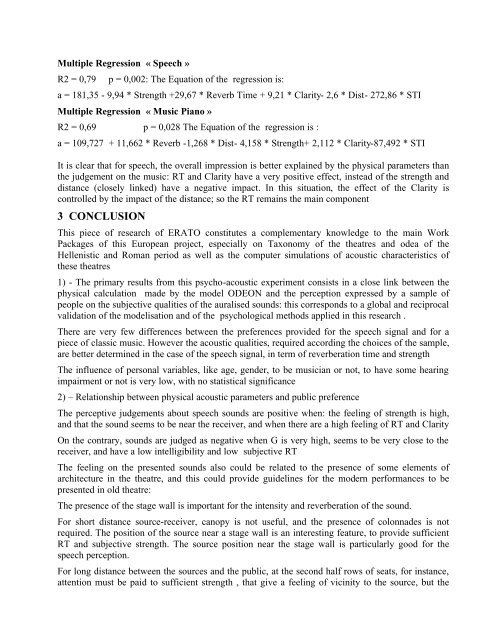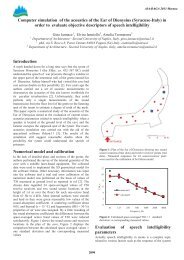ERATO Proceedings Istanbul 2006.pdf - Odeon
ERATO Proceedings Istanbul 2006.pdf - Odeon
ERATO Proceedings Istanbul 2006.pdf - Odeon
You also want an ePaper? Increase the reach of your titles
YUMPU automatically turns print PDFs into web optimized ePapers that Google loves.
Multiple Regression « Speech »<br />
R2 = 0,79<br />
p = 0,002: The Equation of the regression is:<br />
a = 181,35 - 9,94 * Strength +29,67 * Reverb Time + 9,21 * Clarity- 2,6 * Dist- 272,86 * STI<br />
Multiple Regression « Music Piano »<br />
R2 = 0,69 p = 0,028 The Equation of the regression is :<br />
a = 109,727 + 11,662 * Reverb -1,268 * Dist- 4,158 * Strength+ 2,112 * Clarity-87,492 * STI<br />
It is clear that for speech, the overall impression is better explained by the physical parameters than<br />
the judgement on the music: RT and Clarity have a very positive effect, instead of the strength and<br />
distance (closely linked) have a negative impact. In this situation, the effect of the Clarity is<br />
controlled by the impact of the distance; so the RT remains the main component<br />
3 CONCLUSION<br />
This piece of research of <strong>ERATO</strong> constitutes a complementary knowledge to the main Work<br />
Packages of this European project, especially on Taxonomy of the theatres and odea of the<br />
Hellenistic and Roman period as well as the computer simulations of acoustic characteristics of<br />
these theatres<br />
1) - The primary results from this psycho-acoustic experiment consists in a close link between the<br />
physical calculation made by the model ODEON and the perception expressed by a sample of<br />
people on the subjective qualities of the auralised sounds: this corresponds to a global and reciprocal<br />
validation of the modelisation and of the psychological methods applied in this research .<br />
There are very few differences between the preferences provided for the speech signal and for a<br />
piece of classic music. However the acoustic qualities, required according the choices of the sample,<br />
are better determined in the case of the speech signal, in term of reverberation time and strength<br />
The influence of personal variables, like age, gender, to be musician or not, to have some hearing<br />
impairment or not is very low, with no statistical significance<br />
2) – Relationship between physical acoustic parameters and public preference<br />
The perceptive judgements about speech sounds are positive when: the feeling of strength is high,<br />
and that the sound seems to be near the receiver, and when there are a high feeling of RT and Clarity<br />
On the contrary, sounds are judged as negative when G is very high, seems to be very close to the<br />
receiver, and have a low intelligibility and low subjective RT<br />
The feeling on the presented sounds also could be related to the presence of some elements of<br />
architecture in the theatre, and this could provide guidelines for the modern performances to be<br />
presented in old theatre:<br />
The presence of the stage wall is important for the intensity and reverberation of the sound.<br />
For short distance source-receiver, canopy is not useful, and the presence of colonnades is not<br />
required. The position of the source near a stage wall is an interesting feature, to provide sufficient<br />
RT and subjective strength. The source position near the stage wall is particularly good for the<br />
speech perception.<br />
For long distance between the sources and the public, at the second half rows of seats, for instance,<br />
attention must be paid to sufficient strength , that give a feeling of vicinity to the source, but the
















